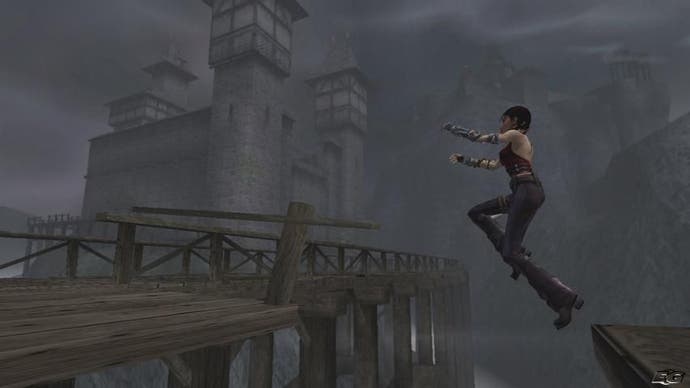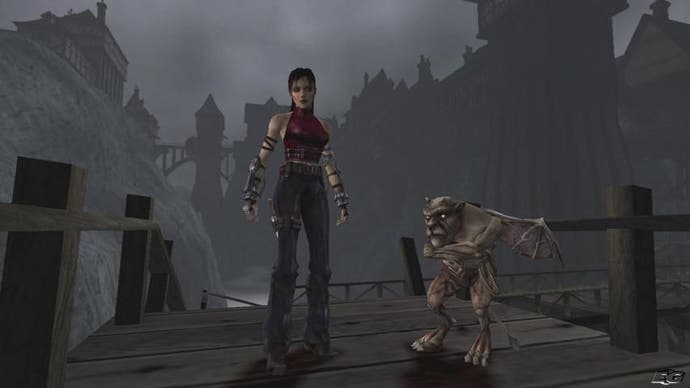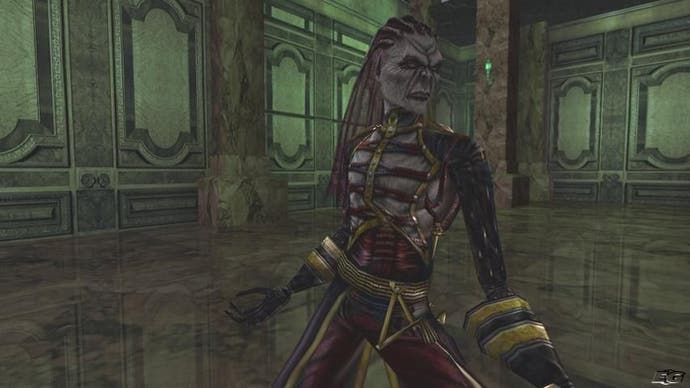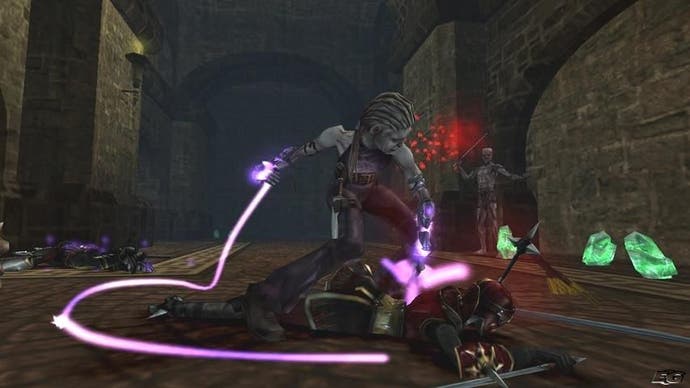Primal
A female videogame star? That'll never work...
Sony Europe really wants Primal to be well received. You can always tell a home grown Sony effort from its American or Japanese brothers, mainly because of the enormous marketing efforts that accompany every SCEE-developed release. As well as the recent Primal Art exhibition, there's been a truck load of advertising and even a lovely super-rare press pack: a whopping great box with a claw slash across the front, revealing a lavish character art book mounted in mock red velvet, and also housing a ribbon tied numbered art print [which Kristan kept, folks -bitter deputy]. Great stuff; but isn't it interesting that such beyond-the-call-of-duty efforts weren't afforded the recent SCEA developed titles Sly Raccoon, and The Mark of Kri? Both total flops in the UK, we might add, despite being two of the best games released on the PS2 this year.
Anyway, yes. Primal. Developed by Sony's Cambridge studio; the same bods that brought us the two award winning Medieval titles, along with the technically excellent, but less revered C-12: Final Resistance. But this is the Big One; its labour of love, where Chris Sorrell and the team have been given the time and the budget to create a lavish, deep, dark, adult action adventure that really shows off their talents and what the PS2 can do.
Sony wants you to believe in Primal and has constructed an elaborate back story for the game world, as well as each of its many characters. The realm that you inhabit during the course of the game is based somewhere between the mortal world and the afterlife, where the balance between order and chaos has tipped dangerously towards the latter. And it's your job, as 21-year-old coffee bar waitress Jennifer Tate, to sort this sorry mess out.

Demon ate my Rock Star
In a coma after witnessing her rock star boyfriend being captured by a giant winged demon, Jen has her spirit ripped from the mortal world by a stone gargoyle called Scree, who insists she is the chosen one, without properly explaining why this is the case. Naturally Jen's a tad confused and concerned. All she wants to do is find her beloved Lewis.
In true gaming tradition, we stick with whatever plot nonsense is thrown at us, because we hope that at some point it will start to make sense. Even if it doesn't, at least there's a decent game to prop it all up isn't there?
But the explanations keep on coming (sorry, we are trying to keep this concise). At the heart of the 'Nexus' sits a being by the name of Chronos, who is fused to a giant machine. He balances the forces of order and chaos across the four realms: Solum, Aquis, Aetha, and Volca, and is having a bit of a rough time of it at the moment, thanks to the battle between Arella (order) and Abbadon (chaos). In a nutshell, this area acts as Primal's hub. Jen, with Scree in tow must visit the four realms in turn and kick whoever's arse needs it most - which is generally most people.
With all the longwinded background out of the way, what about the game? At its core it's a straightforward exploration-based third person action adventure, with its fair share of puzzle elements, object collection and combat. At any point the player can switch between Jen and Scree (by hitting select) in order to progress. Jen, being tall and svelte, can squeeze through narrow gaps and shimmy along ledges, as well as kick the crap out of the numerous minions of doom. Scree, on the other hand, can climb up walls, as well as drain corpses of energy, and 'possess' statues as a means to unlocking doors, or to kick the crap out of enemies otherwise too big to deal with.

Why let one person solve a puzzle when you can have two?
Most doors in Primal's world are far too heavy for one person to open on their own, so guess what? Yes! You have to push/lift them together. The buddy dynamics can be a tad contrived at times, in the same way that Resident Evil Zero foists arbitrary puzzles upon you that only two characters working together could solve, but at times it can work well in an ICO-esque sense. Insisting that two characters must open a door together, however, is just plain annoying after the 15th door.
Scree also serves as the game's in-game hint provider. Tapping triangle prompts the noble gargoyle to offer occasionally useful advice of where to head for next - we say 'occasionally useful' as for the most part his clues are so obscure as to be practically worthless. Sometimes, the best bet is to hit the Start button and observe the map, which will display a symbol to indicate precisely where you should be heading for next. This is important, as the environments are sprawling multi-level affairs, and it's easy to find yourself wandering around cursing bitterly like a headless Mugwum after 14 Hoegaardens. We can't emphasise enough how important it is to keep referring to the map, as Primal can otherwise degenerate into a frustrating aimless wandering farce in no-time. We're emphasising it, because the game certainly doesn't point this vital fact out.

Half Lara, half Dante
Part way through the first realm, it transpires that Jen is, in fact, half demon (Devil May Cry, anyone?) and can transform herself by hitting left on the directional pad. While this undoubtedly fulfils her ostensibly Gothic ambitions, it makes her a better fighter, as well as able to perform higher jumps. As you progress, the range of forms Jen can take increases - for example, in the Aquis realm, the previously aquaphobic Jen is suddenly blessed with the ability to swim underwater without breathing, as well as communicate telepathically. While she assumes this state, she has limited energy, but is able to draw strength from Scree if he's in the near vicinity. Should she run out, Jen switches back to her weakened human form.
Primal tries hard to take the hassle away from the general, everyday controls, by removing the need to learn 14 commands, Tomb Raider-style. Instead, what you get is a context sensitive system that jumps and crouches as and when required. More specific commands, such as performing a shimmy onto a narrow ledge, climbing a rope, pulling a lever, smashing a barrel or opening a door can all be taken care of with use of the X button in the correct scenario. Sometimes it feels like you're playing with a straight jacket on, but it does work reasonably well, allowing the player to concentrate on the task at hand, without degenerating into a trial and error exercise in command learning.

Mash those buttons
Curiously, the combat commands have been assigned to the shoulder buttons. R1 acts as a block, L2 and R2 deliver a strong blow and finishing move when performed at the correct time, while L1, L2 and R2 individually deliver context-specific spins, swipes and kicks. Our preferred method, rather worryingly, was to mash R2, occasionally pull off the finishing move (certain creatures won't piss off until you do), and win every single time, no matter how many creatures tried to eat our face. With no jump command, or individual kick and punch commands, it very quickly feels like the combat was a stitched-on afterthought. In earlier builds we convinced ourselves that the enemy's curious AI must be a quirk that would eventually be rectified. How wrong can you be?
Even if a gang of five monsters appear, the ones that you're not immediately attacking just back off until it's their turn for punishment. They stand around looking utterly gormless, maybe occasionally swiping, but provide very little challenge. To say the combat is a disappointment is the understatement of the PlayStation era, and given that you can avoid confrontation most of the time merely highlights the problem. It's as if these drones have been placed at specific locations to make the world feel more alive, rather than actually offering the player anything other than an irritating distraction, and a chance to fire up a turgid, lamentable Goth rock soundtrack. Without exaggeration, Primal serves up the limpest attempt at combat that we've seen in a modern videogame. It may not be the game's staple diet, but playing this after, say, Indiana Jones, the chasmic gulf in class is there for all to see.
And the annoyances don't end there. The camera system is woeful, and catastrophically short of being an acceptable window to your world. Anywhere near a restrictive viewpoint it freaks out, often turning the viewpoint into a twitching, glitching mess. In Aquis, it's just plain disorientating as you roll and flip underwater unexpectedly, forcing you to switch the compass display on in a vain attempt to get your bearings. It's not something that just happens now and then, either, and conspires to remind you every few seconds that this is a mere videogame, after all.

Pay attention! Assumed knowledge alert!
The tasks at hand rarely inspire much enjoyment either. Most often, the game mechanic is thus: visit point A, view cut scene, go off and get object X, take it to point Y, find out you need to go and talk to character Z, and cue fisticuffs melee. And that's if you know where you're supposed to go. The levels are impressively expansive and carefully crafted, but if you've not been paying 150 per cent attention, the point that Scree suggests that we go and seek out that ornate locked door, you'll want to smash his stupid stone face into dust with a mallet.
So often the game assumes that you'll remember every single character, location and object that you encounter, and repeatedly makes reference to things and places you'll have long forgotten about. As we mentioned earlier, the map displays an icon pointing out where you're aiming for, but that's never made clear. Metroid Prime this most certainly is not, and the lack of any kind of 3D map makes referring to it a painful experience. Of course, you learn your way around eventually, but only after hours of repeat visits.
If it wasn't for the tediously moribund combat, glitchtastic camera and reliance on repeated exploration, Primal might stand a chance of being entertaining. In its favour, the storyline is very well thought out, and provides a credible template for the game. For a fantasy related story to not bore us to death is a triumph in itself, although we'd still have to admit that it's not our cup of freshly drained Ferai blood.
By far the most impressive aspect of Primal is its visuals. The game boasts arguably the most detailed, high-res environments the PS2 has ever seen, and for once we're treated to the full set of 16:9 mode, 60Hz and even Progressive Scan support for those with the necessary kit. The intricately-crafted character models and texture-laden environments feature such a staggering attention to detail, and are seamlessly presented with a Jak & Daxter-esque no-load streaming data system that very rarely trips up. If there's one major incentive to owning or playing Primal, it's to experience one of the best-looking games out there, with a consistently impressive array of tricks that proves yet again that the PS2 has plenty up its sleeve.
To the untrained eye, this has all the hallmarks of a must have title…
It's refreshing, also, to note that the array of cut scenes always utilise the in-game engine, and are no less impressive for it. If anyone can think of a more technically impressive PS2 title, then let us know. A well put together promo video of Primal's glorious moments would mark it out as a must have title.
Sadly, the end result is a long way from the intentions: a rank combat system, quirky camera and a lack of inspiration at the game's exploration/puzzle core make playing the game hard work. The bottom line is that Primal is rarely very much fun. Call us old-fashioned, but isn't having fun the whole point of playing games?
Primal screenshots (PS2)
Primal interview (PS2)
Prima first impressions (PS2)

